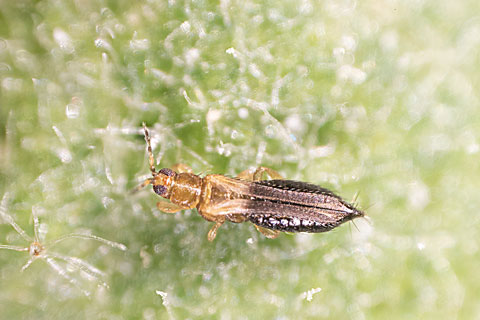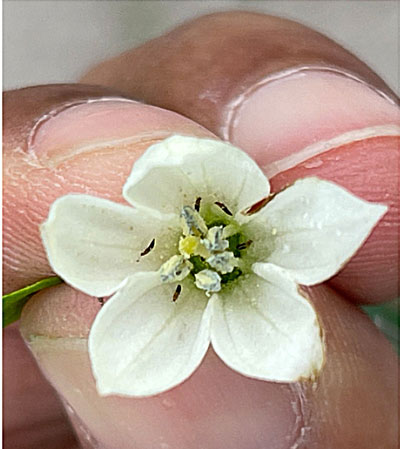8/1/2024
Stay Vigilant in Scouting for Thrips parvispinus
Joanne Lutz & Karen Stever
In the months leading up to the spring of 2023, horticultural scientists started to spread the word about the invasive “new” pepper thrips, officially named Thrips parvispinus. T. parvispinus was found on the U.S. mainland in Florida in 2020, and by the beginning of 2023 was showing its invasive potential. In the year or so since the alarm was sounded, we’ve learned much about this pest from a habit and crop protection standpoint.
By the fall of 2023, T. parvispinus had been officially recorded in Colorado, Georgia, North Carolina and South Carolina, and infested plants had been intercepted in Ohio and Pennsylvania. Griffin’s GGSPro Technical Team started seeing T. parvispinus in ornamental growers’ greenhouses in the eastern states early in 2024.
T. parvispinus causes significant damage to fruit and vegetable crops across the world and has caused significant losses in field-grown peppers in Florida. Crops known to sustain damage by T. parvispinus around the world include a variety of bean types and fruiting vegetables like eggplant, tomato and pepper varieties from paprika to bell peppers. Additionally, cucumbers, squashes and other cucurbits, potatoes, alliums (onion, garlic, leek and shallots), brassicas (cabbage and broccoli), asparagus, okra and fruits (including citrus, watermelon, papaya, mango, guava and strawberry) are all documented as affected crops in available literature.
T. parvispinus was found in the Netherlands in 2019, just ahead of identification in Florida in 2020. It’s now suspected to be present in greenhouse vegetable crops in Northern Europe, as well as greenhouse ornamentals. There have been no reports of infestations in controlled environment vegetable crops within the United States that we know of so far. However, at Griffin, customers are reporting cases of this pest with some regularity now in 2024. This indicates to us that the depth of the situation is still developing in ornamental greenhouses in the eastern half of the country. We note these are unofficial cases, identified by the appearance of the thrips present and the damage observed as described below.
Habit and identification
There’s often a thin line between ornamental propagation and vegetable seedling production that makes crossover between crops more likely to occur. In fact, we’re aware that this exact situation did occur recently. A grower sent in photos of T. parvispinus and their damage in pepper transplants produced in a facility that also produces ornamentals. In this case, the transplants were destined for the retail home market, not a producer. Considering the diversified crops of many growers and greenhouse producers, pepper thrips can easily spread to both ornamental and edible species once it’s present in a facility.
 Figure 1. Adult female Thrips parvispinus. Photo credit: Lance Osborne.
Figure 1. Adult female Thrips parvispinus. Photo credit: Lance Osborne.
It's important to recognize this pest if it gets into your greenhouse. T. Parvispinus are the smallest dark thrips (smaller than chilli thrips) that growers are likely to encounter during production. Females and males differ in size and color. Females are approximately 1 mm long (a little over 1/32 in.) and males are almost half the size at 0.6 mm long. Males are yellow, while the females have a brown head, black abdomen and a distinctive yellow thorax (Figure 1). The wings are dark with a light-colored base where they overlap the thorax. The third antennal segment and the base of the fourth and fifth segments are light-colored, giving them a broken or “striped” pattern. All leg segments are light-colored.
Under controlled conditions on chili pepper (Capsicum annuum) in greenhouses, the life cycle is completed in 13 to 14 days. Eggs are inserted into leaves; after four to five days, larvae hatch to feed on leaves and flowers. Larvae go through two molts in four to five days, mature and pupate. The two pupal stages last two to three days. Reproduction is sexual and females lay 15 eggs on average over their lifetime. Mated females live nine days, whereas adult males live only six days.
This is a pest that can displace the more common thrips species in crops; that shouldn’t be taken lightly. They’re said to establish in greenhouses and
the overwintering capability outdoors is currently unknown. In addition, T. parvispinus has been shown to be active down to 45F (7C).

Where to look
T. parvispinus prefers tender young growth tips early on in a crop, but will largely move to the flowers as plants prepare to set fruit for fruiting crops such as peppers. These thrips are difficult to find on foliage due to their size, relative speed and ability to hide in the deformed growth. However, they’re easily spotted in contrast to white flowers of pepper plants (Figure 2). Scouting tools should include a good hand lens and a white sheet of paper on a clipboard or a tray to conduct a “beat test.” As with other thrips species, sticky cards are also effective at detecting the presence of adults. Different colors of cards may be more attractive than others, depending on the seasonal light intensity and light quality transmitted by greenhouse coverings.
Figure 2. Thrips on a pepper flower. Photo credit: Lance Osborne.
Scouting and early detection is the key to controlling this pest. Distorted and rolled tips can prevent dislodging the insects when using a beat test, so dissect suspicious tips if necessary. With pepper thrips, damage may show before the thrips appear on sticky cards. Once detected, place sticky cards for weekly monitoring or tape for mass trapping with about one-third of the card below the top of the canopy.
Crop protection and outlook
Researchers at the University of Florida are providing insights into the efficacy of chemical controls against T. parvispinus. These researchers point out that they’re not ready to make formal recommendations for spray programs or rotations and more research is needed. So far, the most promising active ingredients/modes of action (MOA) appear to be Spinosad and Spinetoram (both MOA 5), Chlorfenapyr (MOA 13) and Tolfenpyrad (MOA 21A). Additionally, a number of products stopped the pest feeding and may show further utility with additional testing.
Further research is also planned for certain tank mixes of conventional active ingredients and biological (fungal) insecticide options. What’s clear at this point is that the options for control of T. parvispinus will be limited compared to effective controls for western flower thrips and rotation to avoid further resistance will be paramount. Controlled environment/greenhouse producers will have fewer control options than field growers.
This new thrips, T. parvispinus, is an invader. It hasn’t made its way into controlled agricultural environments yet, that we know of, but that’s likely coming, as the pest progresses across the states through the floriculture trade in the United States. Now is the perfect time to learn how to recognize the signs of this potentially destructive pest and learn how to scout for it. Early detection and proper identification are key to the most economical control possible if pepper thrips find a way into your greenhouse.
Joanne Lutz and Karen Stever are both Technical Support Specialists at Griffin Greenhouse Supplies—GGSPro. If you have any questions, please contact your local Griffin Sales Representative or GGSPro at ggsprotech@griffinmail.com.
More Resources
For more resources and links about Thrips parvispinus from UF/IFAS visit https://mrec.ifas.ufl.edu/lsolab/thrips/thrips-parvispinus/ and https://trec.ifas.ufl.edu/people/alexandra-revynthi/thrips-parvispinus/